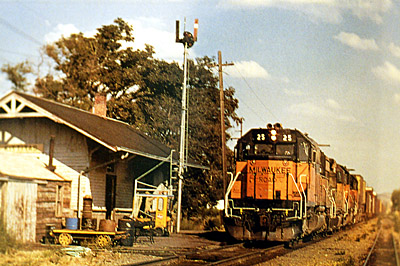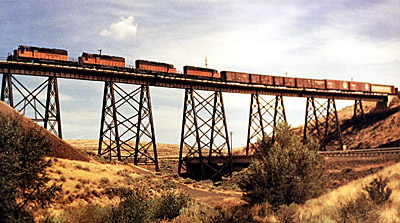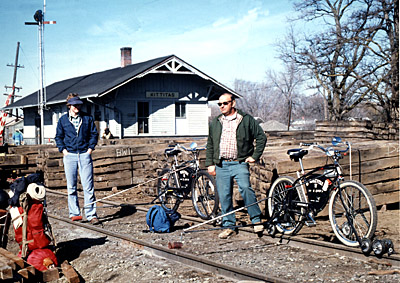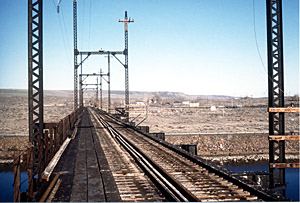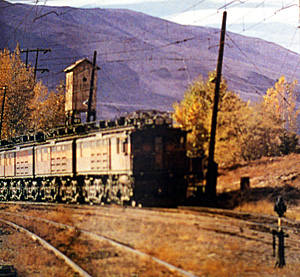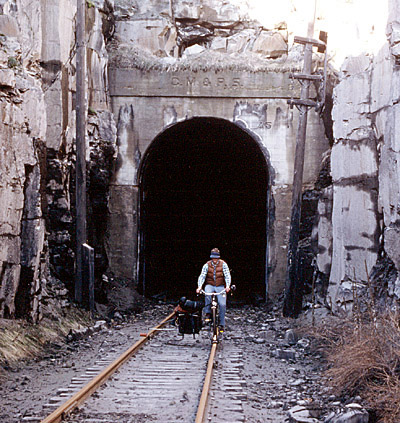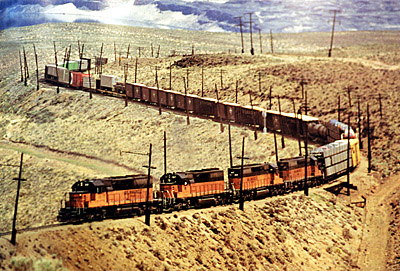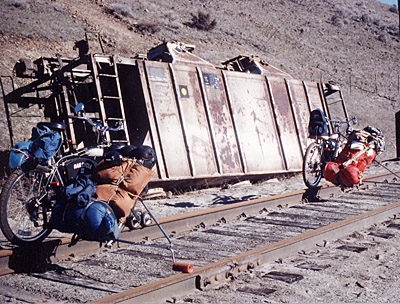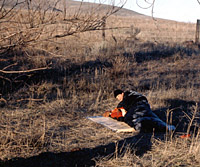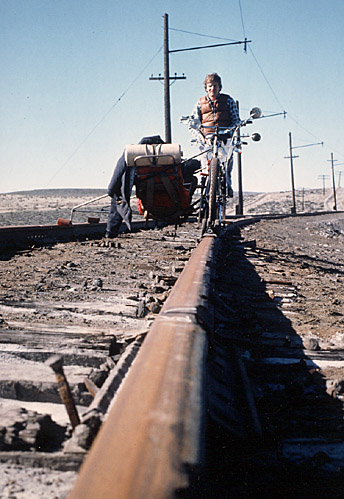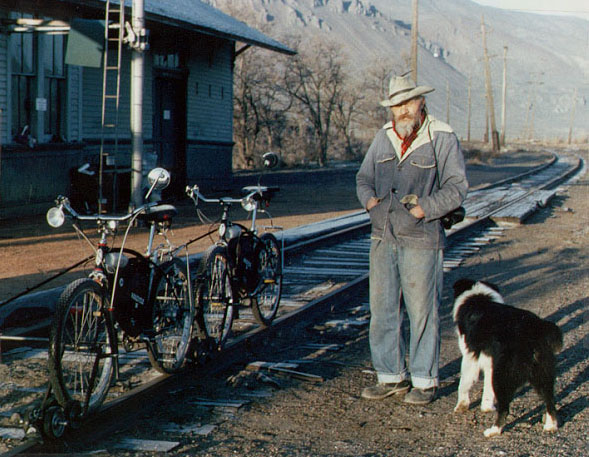The Mayor of Beverly
by Richard Smart
A westbound freight crosses Interstate 90 on Renslow Trestle about five mils east of Kittitas.
I remember it being uncomfortably windy when we rode across this trestle in February 1981.1
Al Parrish, a railroad salvager in Kittitas, Washington, told us to be sure to meet the "Mayor of Beverly". "The Mayor," he said, was actually a hobo known on the rails as "Oklahoma Slim".
Jim McNamara and I were on a trans-Washington railcycle trip. We were following the abandoned tracks of the Milwaukee Road Railroad between Easton, which is in the foothills of the Cascades, and Rosalia, which is about thirty miles south of Spokane. It was near the end of February in 1981 when we began this extraordinary trip. The Milwaukee Road had filed for bankruptcy the March before and then two months later Mt. St. Helen erupted, burying the railway in volcanic ash. The final curtain was falling on this magnificent railroad which at one time was the longest electrified railway in the world. If we were to railbike the Milwaukee Road and see the sights the passengers had seen aboard the Olympian Hiawatha, then now was the time to go, in the dead of winter, because there never would be another opportunity. Fortunately, the weather was much milder that winter than our usual winters in the Pacific Northwest.
Parrish (right), a railroad salvager in Kittitas, told us to be sure to meet the Mayor of Beverely.
By late afternoon on March 1, we were crossing the high bridge over the Columbia River and were approaching the small settlement of Beverly. The salvagers had already removed the last few miles of track into Beverly. Bearing heavy backpacks, we had had to fold up the outriggers and pedal our bikes across the mighty Columbia on four narrow timbers. It was a 'rush' peering down between the bridge timbers at the murky water below. That experiace still ranks high on my adventure chart.
We arrived at the railroad Station in the late afternoon and it was obvious that Beverly had been directly down wind from
Crossing the Columbia. Some of the rails
were gone and we rode across on planks.
At Beverly, electric helper engins were kept
to aid trains over the Saddle Mountains.
Beverly had been the proud servant for one of the finest railways in the world. At one time the Olympic Hiawatha was the fastest way to travel between Chicago and Seattle. Thousands of travelers, including presidents, movie stars, solders, and hobos had followed the route of the Milwaukee Road. It seemed only fitting to me that a hobo from the past had chosen this quiet desert town on the banks of the Columbia and had returned to become its honorary mayor.
It was getting dark and a cold wind was blowing when we found the mayor's boxcar shaped shack at the edge of town. I walked up a few stair steps and knocked on the door. A gruff voice called out from the back of the cabin "Who's there?". I told him my name and that Al Parrish from Kittitas had told us to stop by and visit the mayor. We waited a few moments until the door was unlatched. Appearing before us was a wild looking man with a pointed beard and a shaggy mustache. The light from the open door lit up his face showing a long scar that ran down the side of his cheek. He wore cut off pajamas that were torn and ragged and blew in the wind! His eyes were friendly, but he showed concern about us being there. I told him again about how Al Parrish had encouraged us to meet the Mayor. His eyes then sparkled and he invited us in. The warmth of his home felt good to us.
I noticed a variety of items entangled in a maze of spider webs on the shelf across the room. A railroad lantern with a missing lens, a few spikes and date nails, and some very interesting rocks of all different colors sparked my interest. I kept thinking about the hundreds of thousand of miles that this fellow had traveled by rail across America and throughout Canada.
As we talked with the mayor that evening, it became clear that the graphics on his walls were accurate symbols of his outlook on life. Oklahoma Slim was a happy man who truly cared about people. He was pround of his past and he shared openly with us some of the good and bad times of hobo life. We were to later find out that Oklahoma Slim had spent part of seven decades riding the rails.
Jim exits Boylston Tunnel at the summit of the Saddles. Note the flashlight mounted on the guide
wheel is still oh after pedaling through the blackness.
The first time that I mentioned the word hobo he adamantly stated that most people do not understand the
I replied that I had seen logos under railroad bridges while railbiking, and he smiled with satisfaction. Jim then asked him about some of the hard times he had had while riding the rails. Oklahoma Slim thought for a moment and then began telling us about the time that he had to run back and forth inside a boxcar to keep from freezing to death as the freight made its way over the mountains. He shared with us an incident from the thirties when he had to fight a fellow with a knife while standing on top of a moving freight train. He also mentioned a friend who had his leg amputated by a sliding boxcar door. The stories went on and on. He left home when he was seven years old and had been riding the freights on and off ever since. (I plan to share more of his stories with you on our web
site). Until his death in 1999, I stopped by to see the mayor whenever I had the opportunity. I usually brought a fruit basket and a friend, and we spent the evening sharing railroad stories.
Jim and I bid the mayor good-bye and headed back to the deserted railroad depot to spend the night. The mayor had asked us to have a cup of coffee waiting for him in the morning because he was coming by to look at the Railcycles.
A westbound freight snakes its way up the seventeen miles of 2.2%
grade to the summit at Boylston. The Milwaukee crossed five major mountain ranges between Chicago and the Puget Sound.
Westboud Freight arrives in Kittitas. Note the semiphore signals.
The next morning the mayor arrived with his dog, Bo (appropriately named) to see us off. He loved the Railcycles and told us that it was a sport that he would have loved to have done in his earlier days. After watching Bo do a few of his tricks for his master, we headed esatbound toward Othello. As we rode along, I looked into my rear view mirror to see the mayor and Bo standing between the rails, watching us ride off into the distance.
He was eighty-four years old when he died. A picture of Oklahoma Slim hangsover our fireplace at my home in Coeur d'Alene, Idaho. Okahoma Slim was buried in a cemetery near the tracks in Quincy, Washington. On his grave stone is this inscription: YOU PLAY WITH THE HAND THAT YOU ARE DEALT.
"A hobo is a migratory laborer and a tramp is a migratory non-laborer and a bum is a non-miratory non-laborer".
We saw many wrecked cars along the way.
Heavy frost on the sleeping bags.
Salvage has begun. Note the spikes have already been pulled up
Mt. St. Helen. Volcanic ash was everywhere! We left our packs in the depot and walked around town looking for the mayor. Like so many other settlements that served the Milwaukee Road, Beverly was just another victim of the railroad's abandonment. As the railroad gradually deteriorated, the town had fallen into disrepair. At Beverly, helper engins were kept to aid west and
eastbound freights over the Saddle Mountains.
Heat was radiating from a pot-bellied stove in the center of the room. I noticed life-like human figures painted on the walls. People, representing different races and nationalities, were reaching out with their hands as if to be warming themselves over his stove. On another wall he had painted a string of boxcars as a background with the focus on a hobo camp nestled near the rails and close by as stream. Two hobos were sitting together on a log sharing food over an open fire.
Oaklahoma Slim
The Mayor of Beverly "Oklahoma Slim" and "Bo"
true meaning of the word. He went on to say that a hobo is a migratory laborer and a tramp is a
migratory non-laborer and a bum is a non-migratory non-laborer.
"How did you get your hobo name?", Jim asked. "Well," said the mayor, "I'm slender and I'm from Oklahoma. Do you want to see my logo?" He sketched OKLASLIM and handed it to Jim. "Hobos," he said, "would travel around the country writing their logos on boxcar doors, under bridges and overpasses. Along with their logo, they would often write the date and the serial number of the boxcar that they were riding in at the time. Look at these logos," he added. TWO-TOP-TRAMP, A-NO-1, BURMA SHAVE, WALKING STICK, UNCLE FREDDY, SAFARI SAM, MAN CALLED JOHN, GYPSY MOON. "I knew most of these guys".
Use your browser's back button to get home and you won't have to re-enter the password.
